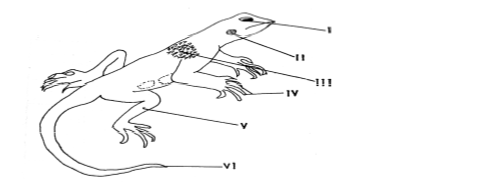Question 1
- The diagram below is an illustration of an organism. Study it and answer questions 1(a) to 1(e).

(a) (i) Identify the organism in the diagram. [1 mark]
(ii) Name the parts labelled I to VI.
I: ___________________________ IV: ________________________
II: __________________________ V: _________________________
III: _________________________ VI: _________________________
[6 mark]
(b) (i) Name one habitat of the organism. [1 mark]
(ii) State three observable features that adapt the organism to its habitat.
[6 mark]
(iii) State one behavioural adaptation of the organism to its habitat.
[2 marks]
(c) (i) what is the likely sex of the organism?
[2 marks]
(ii) Give two reasons for the answer in 1(c)(i).
[2 marks]
(d) (i) Name the Class to which the organism belongs.
[1 mark]
(ii) Give one reason for the answer in 1(d)(i).
[1 mark]
(iii) Name three other members of the Class named in 1(d)(i).
[1 mark]
(e) What is the mode of feeding of the organism?
[1 mark]
Observation
In this question, most candidates were able to name the organism correctly but those who gave the taxonomical name must begin with capital letter to score.
Many candidates lost marks in the labels because of wrong spellings.
Some candidates also lost marks to the habitat because they did not give the exact habitat but stated terrestrial which made them lose marks.
Many candidates who were able to correctly identify the Class of the organism as Reptilia lost the mark to wrong spelling or starting the word with a small letter.
In identifying the mode of feeding of the organism, many candidates did not spell the word carnivorous, heterotrophic or insectivorous correctly.
The expected answers are:
(a) (i) Identification of organism
Lizard/Agama lizard/Agama agama
Note: spellings must be correct to score.
(ii) Name of labelled parts
I - eye IV - claws/digits
II - tympanic membrane/tympanum/eardrum V - hind limb/hind leg
III - scale VI - tail
Note: spellings must be correct to score.
(b) (i) Habitat of organism
(Crevices/cracks) on walls; land; trees; garden.
Note: spellings must be correct to score.
(ii) Observable features that adapt the organism to its habitat
- Presence of claws; for climbing;
- Presence of fore limbs and hindlimbs; for walking/locomotion;
- Presence of (dry horny) scales; for protection/prevents desiccation;
- Presence of tympanic membrane; for detecting sound;
- Presence of mouth; for feeding;
- Presence of nostril; for breathing;
- Presence of eye; for vision;
- Presence of tail; for balancing during movement;
- Presence of tail that is detachable; to escape danger.
(iii) Behavioural adaptation of the organism to its habitat
- Basking in the sun; to raise its body temperature/moves
to worm or cold environment as the need arises;
- Sharing territory with the male; for protection;
- Camouflage to escape predator;
- Bury eggs in the soil; for protection/warmth.
(c) (i) Sex of the organism
Female.
Note: spellings must be correct to score.
(ii) Reasons for the answer
- Gular fold/Dewlap not prominent/absent;
- Nuchal crest reduced/absent.
(d) (i) Class of the organism
Reptilia.
Note: spellings must be correct to score and must begin with capital letter.
(ii) Reasons for the answer
Presence of (dry horny) scales.
(iii) Other members of the Class
Snakes; Crocodile; Alligator; Tortoise; Gecko; Turtles; Monitor lizard;
Chameleon.
(e) Type of Mode of feeding of organism
Carnivorous/heterotrophic/holozoic/insectivorous.
